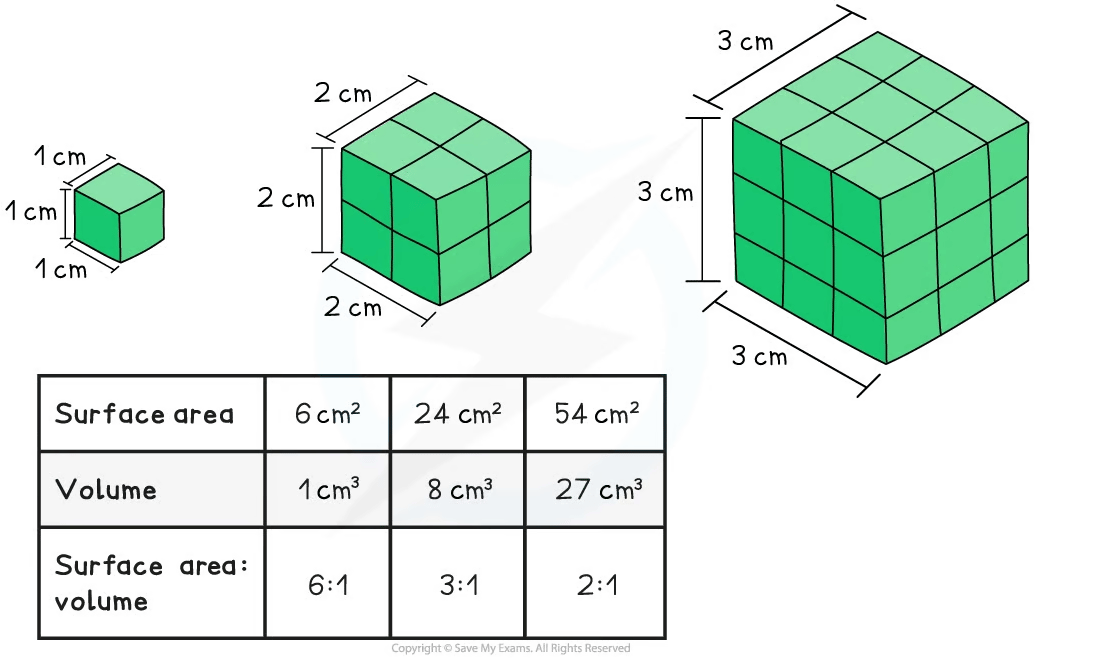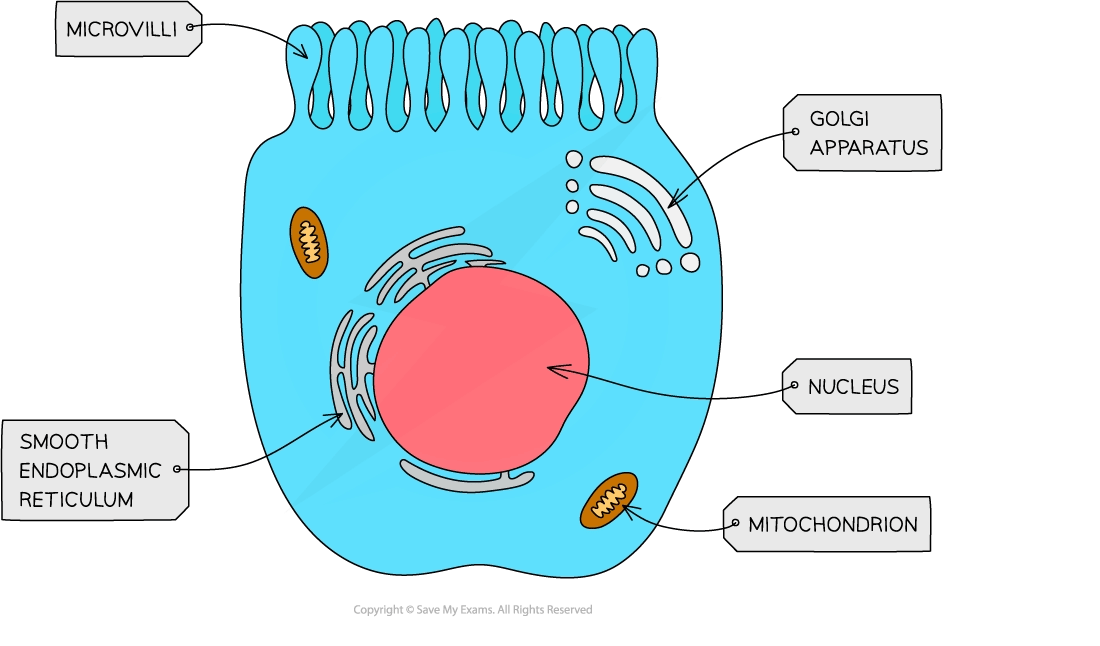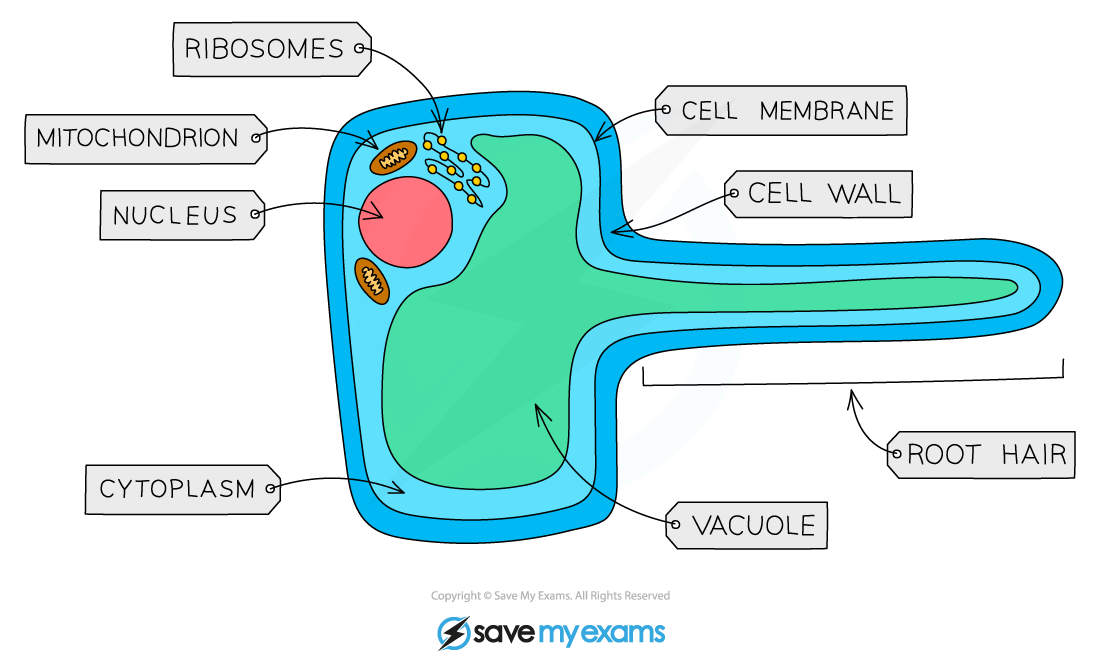Cells & Surface Area (College Board AP® Biology) : Study Guide
Surface area-to-volume ratio
Surface area and volume are both very important factors in the exchange of materials in organisms
Surface area refers to the total area of the organism that is exposed to the external environment
Volume refers to the total internal volume of the organism (total amount of space inside the organism)
As the surface area and volume of an organism increase (and therefore the overall "size" of the organism increases), the surface area : volume ratio decreases
This is because volume increases much more rapidly than surface area as size increases

Importance of surface area-to-volume ratios
Having a high surface area-to-volume ratio increases the ability of a biological system to perform the following important functions
obtaining necessary resources e.g. oxygen, glucose, amino acids
eliminating waste products e.g. carbon dioxide, urea
acquiring or dissipating thermal energy (heat)
exchanging chemicals and energy with the surroundings e.g. absorbing hormones at the cell surface in the hormone's target organ
Calculating surface area-to-volume ratios
| Sphere | Cube | Rectangular Solid | Cylinder |
|  |  |  |  |
Surface Area | | 6s2 | 2lh + 2lw + 2wh | |
Volume | s3 | l × w × h | | |
Example | If r = 1 cm V = 4/3 πr3 ∴ SA:V ratio = 4:4/3 | If s = 1 cm V = s3 = 13 =1cm3 | If l = 4cm, w = 2cm, h = 1cm, then V = 4 × 2 × 1 ∴ SA:V ratio = 28:8 | If r = 2 cm and h = 6cm, then V = π(2)2 × 6 = 24π cm2 ∴ SA : V ratio |
The surface area:volume ratio calculation differs for different shapes (these shapes can reflect different cells or organisms)
Worked Example
Calculate the surface area-to-volume ratios of the two following microorganisms:
A bacterial cell from the species Staphylococcus aureus; these are spherical cells with a diameter of 800 nm (8 × 10-7 m)
A bacterial cell from the species Bacillus subtilis; these are rod-shaped cells which you can assume to be cylindrical. They are 5 µm long and 1 µm in diameter
Comment on your calculated answers.
Answer:
Spherical cell: diameter = 800 nm, therefore radius = 400 nm
In order to compare cell 1 with cell 2, convert the radius value into µm by dividing by 1000
Radius =
Surface area = {formula from the formula sheet}
=
= 4 × 3.14 × 0.42
= 2.01 µm2
Volume = {formula from the formula sheet}
=
= 4/3 x 3.14 x 0.43
= 0.268 µm3
A ratio is one number divided by another, therefore SA:Vol ratio
=
= 7.5: 1
___________
Cylindrical cell: radius= 0.5 µm (half of diameter 1µm)
Surface area = {formula from the formula sheet}
=
= (2π × 0.5 × 5) + (2π × 0.52)
= 15.708 + 1.571 µm2
= 17.278 µm2
Volume: formula is πr2h
= π × 0.52 × 5
= 3.927 µm3
___________
The spherical cell of Staphylococcus aureus has a surface area-to-volume ratio of 7.5 : 1
The cylindrical cell of Bacillus subtilis aureus has a surface area-to-volume ratio of 4.4 : 1
The spherical cell has the largest surface area-to-volume ratio of all shapes of cells for a given radius/diameter. The larger the surface area-to-volume ratio, the better adapted to simple diffusion that organism is.
Examiner Tips and Tricks
You will be able to use a formula sheet in your AP Exam, although you will be expected to be able to calculate the SA:V ratio for a sphere, cube, rectangular solid or cylinder from these formulae, and explain how the increasing size of an organism affects the SA:V ratio.
Maximizing surface area-to-volume ratio
As organisms increase in size, their surface area to volume ratio decreases
Small cells have a high surface area-to-volume ratio and more efficient exchange of materials with the environment
Larger cells have a lower surface area-to-volume ratio and are less efficient at exchanging materials with their environment
Materials exchanged include
oxygen
carbon dioxide
water
heat exchange
Some single-celled organisms can rely on simple diffusion alone to exchange materials with their environment
More complex cellular structures (e.g. membrane folds) are necessary to exchange materials with the environment adequately
As organisms evolved from single-celled to multicellular, more sophisticated exchange systems (e.g. lungs) evolved to maintain diffusion rates that were high enough to sustain life
Examples of exchange structures
Exchange structures may evolve to be specially adapted to maximize exchange
Gut epithelial cells
A cell on the inside surface of the small intestine is in contact with the flow of food passing through the lumen of the intestine
The cell's principal role is to absorb important nutrient molecules for distribution around the rest of the organism's body
Only one surface of the cell is in contact with the food flow; this is the upper surface as shown
The remaining surfaces of the cell are in direct contact with other cells in the tissue, so cannot absorb food molecules directly from the lumen
So the surface area of the food-contacting surface is maximized by folded structures called microvilli
These increase the internal surface area of the small intestine by a factor of around 100

Root hair cells
Root hairs are single-celled extensions of epidermis cells in the root
They grow between soil particles and absorb water and minerals from the soil
Root hair cells are adapted for the efficient uptake of water (by osmosis) and mineral ions (by active transport)
Root hairs increase the surface area of plant roots, increasing the rate at which water and minerals can be absorbed

Guard cells
Guard cells surround stomata on the lower surface of a leaf; their role is to expand and contract which opens and closes the stomata allowing for gas exchange
The surface area-to-volume ratio of guard cells changes as they expand and contract
As guard cells become turgid, they curve outward which creates a larger stomatal opening
This increases the effective surface area for gas exchange
The small size of guard cells relative to the open stomata ensures efficient diffusion of gases, as the surface area-to-volume ratio is high for the pore area

You've read 0 of your 5 free study guides this week
Unlock more, it's free!
Did this page help you?

